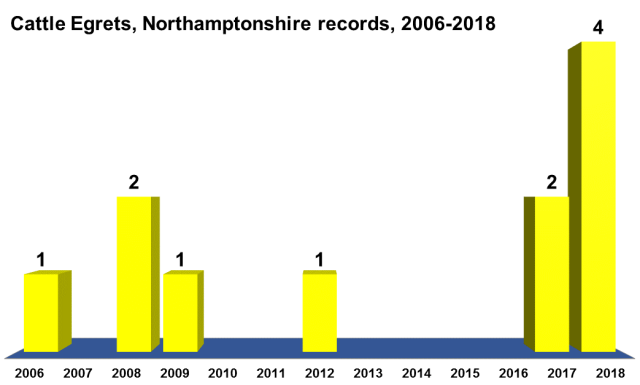This blog is based on Mike Alibone’s blog on the same subject – a must read every week (or more) for Northants birders and with enough interesting information to be of wider than local interest.
I’ve become a little blase about Cattle Egrets in the last 12 months as there have been regular sightings of up to four birds at my local patch of Stanwick Lakes. I’ve seen them a few times but it is by following Steve Fisher’s almost daily sightings on Twitter (@stanwicktramp) and the sightings of others tagged with #northantsbirds that I keep up to date.
I think I saw my first Cattle Egret in the Camargue many years ago, in the 1980s, but I didn’t see my first one in the UK until my birthday in 2008 – 11 years ago. And that bird was on the Northants/Cambridgeshire border and, I think, in Cambs.
But after regular records over the winter which lasted into the spring and summer at Stanwick Lakes it has been pretty apparent that they have been breeding somewhere not a million miles away.
Given that this species was first recorded in Northants as recently as 2006 it’s a pretty rapid establishment to be breeding in 2019.

But breed they have – and the young are fledging now.
At Stanwick Lakes now, Little Egrets are common, Great Egrets are very regular and Cattle Egrets have made their appearance. Yesterday 4 Spoonbills apparently flew through. In winter you can regularly see Bitterns nowadays.
When I first began living in Northants, in 1983, I would not have imagined that paragraph being true of my local birding patch. Times are a changing.
See Mike Alibone’s Northants birds blog for more information about the colonisation of the UK by Cattle Egrets and the status and behaviour of the Northants Cattle Egret threesome.
[registration_form]
Hi Mark
A piece came out throught the news services yesterday- breeding confirmed in Northants, Essex and Hampshire. It is one of the most ubiquitous species globally – I think it might have been recorded on every continent or some such similar pointless fact…..
NOne reported here in Cambs for a few weeks but I betthey are out there quietly lurking, waiting till the birders get round to going out recording again
It is amazing to think that it is originally an African species (there is also an Asian sub-species). It spread into Spain in the early 1950s and first bred in the Camargue only in 1969, eventually becoming a common breeding bird there and continuing its spread northwards. It is rather susceptible to cold winters and the succession of mild winters has no doubt helped it to gain a foothold here.
The populations in the Americas are also of African origin with birds first crossing the Atlantic to South America and eventually spreading from there via Central America into the US.
With the exception of Antarctica you are correct that it is present on every continent and abundant in most of them. An impressive little creature!